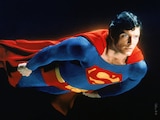The 1960s were a wild, rocky time in American history, and that was true in the world of the Dark Knight as well, who faced a serious sales slump until an out-of-nowhere television hit reinvigorated the character and expanded his world even further. New fans found themselves drawn to Batman and his family of crimefighters, which provided a welcome escape from the political turmoil and destructive war that roiled the nation. But perhaps most significant to DC readers was the debut of an iconic super-team…
1960s

To defeat the alien starfish Starro the Conquerer, Batman became one of the founding members of the Justice League of America in The Brave and the Bold #28 (February 1960), fighting alongside team members that included Wonder Woman, the Flash, Superman, Aquaman, Martian Manhunter and Green Lantern.
Yet, while comic book super-teams may have been taking off, by 1964 the sales of Batman and Detective Comics were sinking, and the series were in danger of being canceled. To stem the slide in sales, the books were assigned to editor Julie Schwartz. Designs by Carmine Infantino ushered in a new look for Batman.
Changes included a yellow oval around the bat on the hero’s chest, a new Batmobile, and a hotline to police headquarters. Batwoman, Ace and Bat-Mite were retired, and the focus turned to crime and detective stories. Faithful butler Alfred was killed off, Dick Grayson’s Aunt Harriet came to live with Bruce and Dick, and classic criminals like the Riddler and Scarecrow, who had not been seen since the 1940s, were reintroduced.

The campy, colorful Batman television series starring Adam West and Burt Ward made its debut on January 12, 1966. A huge ratings success that aired with two new episodes every week, the show spawned an unprecedented number of tie-in toys and merchandise, and it also inspired a new generation of Batman fans. Sales of the Batman comics soon soared.
Created at the request of the Batman TV show’s producers, a new Batgirl made her debut in Detective Comics #359 (January 1967). She was revealed as the teenage daughter of Gotham City’s police commissioner James Gordon, who never knew that Barbara snuck out every night to fight crime. Luckily, she always made it home in time to pursue her studies in forensic psychology.

After the Batman TV series was canceled in 1968, and despite the modest success of an animated follow-up called The Batman/ Superman Hour that ran from 1968 to 1969, sales of the comics once again fell. In Batman #217 in 1969, Dick Grayson left for college, and Bruce Wayne closed Wayne Manor to move into a penthouse apartment, the first step in a move to reestablish a “back-to-basics” atmosphere for the character that would continue throughout much of the next decade.
1970s
In the early 1970s, the Joker and the rest of the Rogues Gallery were out of the picture, at least for a while. Batman operated alone and relied on his wits, solving mysteries and fighting street thugs in back alleys. Gone were the excesses and camp of the 1960s. Batman had returned to his original incarnation: a shadowy figure haunting Gotham by night and striking fear into the hearts of criminals.
1971 saw the arrival of the mysterious and all-knowing villain Ra’s al Ghul in Batman #232, written by influential bat-scribe Dennis O’Neil and drawn by Neal Adams. Over the years, the immortal Ra’s al Ghul would develop into a world-class threat and one of Batman’s most persistently challenging villains.

O’Neil and Adams continued their legendary run with Batman #251 in 1973, which reintroduced the Joker as a violent and murderous threat after he had spent the past several decades as a prankster. In “The Joker’s Five-Way Revenge,” the groundwork was laid for the introduction of the now-iconic Arkham Asylum, which would make its first appearance (as Arkham Hospital) in Batman #258.
The still-beloved Batman of the 1960s returned to television over a decade later when The New Adventures of Batman animated series premiered on February 12, 1977. Featuring the voices of Adam West and Burt Ward as the Dynamic Duo, the series continued airing under different names until 1981.
Look for more on Batman’s long history of heroics next week as part of DC’s Batman 80th anniversary celebration.




















